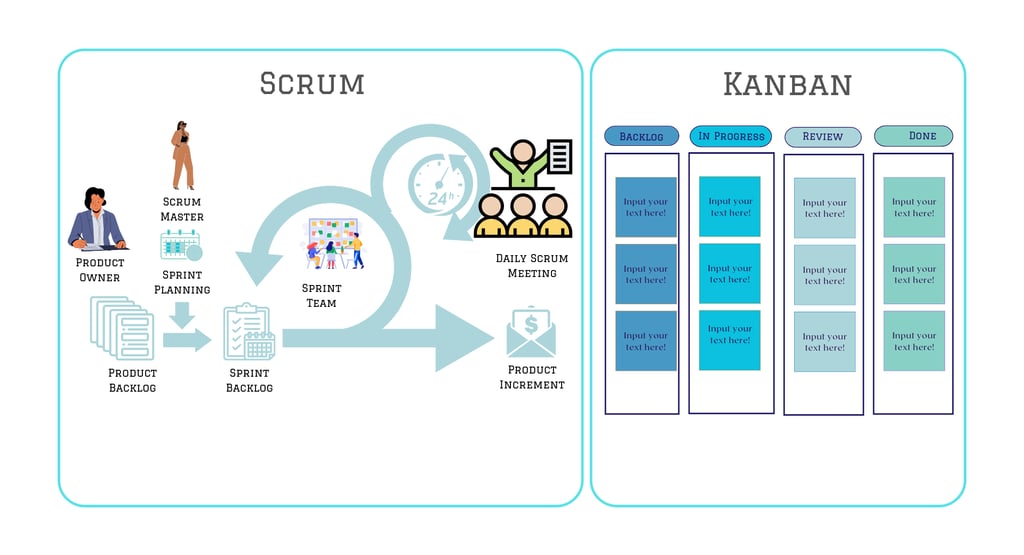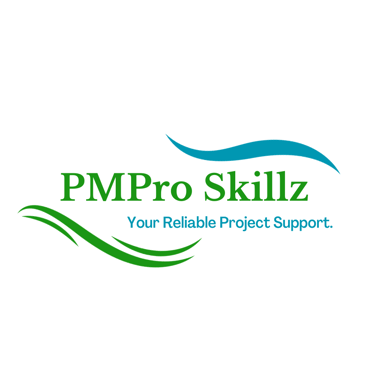Choosing Your Perfect Agile Fit: Scrum vs. Kanban
Both Scrum and Kanban offer powerful tools for improving productivity and collaboration in Agile teams, but they cater to different needs and environments. Scrum’s structured approach and focus on predictability make it an excellent choice for teams needing clear guidance and regular progress checks. On the other hand, Kanban’s emphasis on flexibility and continuous delivery is ideal for teams that need to adapt quickly to changing circumstances.
Iyanna Trimmingham
8/16/20244 min read


Agile project management has transformed the way teams deliver value, offering a flexible, iterative approach that adapts to the needs of modern businesses. With a variety of Agile frameworks available, teams have a wealth of options to choose from. However, two frameworks have stood out for their popularity and effectiveness: Scrum and Kanban.
While both Scrum and Kanban aim to improve productivity and enhance collaboration, they take different paths to achieve these goals. Understanding the nuances between these two can help you choose the framework that best fits your team’s needs and project requirements. Today we will explore how Scrum and Kanban differ, and which might be the perfect Agile fit for you.
Scrum
Scrum is all about structure and predictability. It’s designed to give teams a clear path to follow, with defined roles, regular ceremonies, and a focus on delivering value in short, consistent cycles.
Fixed-Length Sprints: Scrum breaks work into fixed-length sprints, usually lasting one to four weeks. Each sprint with its own goals and deliverables. The idea is to maintain a steady rhythm, allowing teams to plan, execute, and review their work in regular intervals.
Defined Roles: Scrum is big on roles. The Product Owner manages the backlog and prioritizes work. The Scrum Master keeps the team on track, clearing obstacles and ensuring the Scrum process is followed. The Development Team actually does the work, focusing on delivering the sprint’s goals. These roles help keep everyone aligned and accountable.
Specific Ceremonies: Scrum’s process is built around key ceremonies—Sprint Planning, Daily Standups, Sprint Reviews, and Retrospectives. These meetings ensure everyone knows what’s happening, what’s coming next, and what can be improved. It’s a disciplined approach, which is great for teams that thrive on structure.
Strengths of Scrum
The sprint cycle provides a predictable, steady pace, making it easier to track progress.
Defined roles and ceremonies keep everyone on the same page and ensure that nothing falls through the cracks.
Ideal for teams new to Agile who need clear guidelines and a strong framework to follow.
Challenges of Scrum:
The rigidity of the sprint structure can be a drawback if priorities shift often.
The ceremonies and roles, while useful, can sometimes feel like overhead, especially for smaller or more experienced teams.
Scrum requires buy-in from everyone involved—without commitment, it can become just another set of meetings.
Kanban
Kanban, on the other hand, is the poster child for flexibility. It’s less about following a set process and more about visualizing work, limiting work in progress, and continuously improving how work flows through the system.
Visualizing Work: Kanban is built around the Kanban board—a visual tool that displays the flow of work items across different stages, like "To Do," "In Progress," and "Done." This visual approach makes it easy to see where work is bottlenecking and where things are moving smoothly.
Limiting Work in Progress (WIP): One of Kanban’s core principles is limiting the amount of work that’s in progress at any given time. By setting WIP limits, teams can focus on finishing tasks before starting new ones, which helps reduce cycle time and keeps things moving.
Continuous Flow and Delivery: Unlike Scrum’s sprint cycles, Kanban promotes a continuous flow of work. There are no fixed-length iterations; instead, tasks are pulled into the workflow as soon as there’s capacity. This makes Kanban incredibly flexible and responsive, perfect for teams that need to adapt on the fly.
Strengths of Kanban
The flexibility to pull in work as needed without waiting for a sprint to end.
Continuous flow means faster delivery of tasks, which can lead to quicker feedback and improvements.
The visual nature of Kanban boards makes it easier to identify and address bottlenecks in the process.
Challenges of Kanban
The lack of structure and roles can be challenging for teams that need more guidance.
Continuous flow can sometimes lead to a lack of formal reflection points, which are built into Scrum’s regular retrospectives.
Without set milestones, it can be harder to track long-term progress and plan for future work.
Scrum or Kanban?
So, which one should you choose?
Well that really depends on your team’s needs, the nature of your projects, and your organizational goals.
Scrum is a great choice if your project has well-defined goals, and you need the discipline of regular cycles to keep everyone on track. It’s especially useful for teams that are new to Agile, as it provides a clear framework to follow.
Kanban is better suited for teams that deal with a continuous flow of work, like support or operations teams. Its flexibility allows you to react quickly to changes without the need to wait for a sprint to end. Kanban is also a good fit for more experienced Agile teams that are comfortable managing their own process.
For some teams, the best approach might actually be a hybrid—Scrumban—which combines the structure of Scrum with the flexibility of Kanban. This allows you to maintain the predictability of sprints while taking advantage of Kanban’s visual work management and WIP limits.
Conclusion
Scrum and Kanban both offer powerful tools for managing work in an Agile environment, but they take different paths to achieve their goals. Scrum’s structured, role-based approach provides clarity and predictability, making it ideal for teams needing a solid framework. Kanban’s flexible, flow-based model is perfect for teams that need to stay nimble and responsive. By understanding the strengths and challenges of each, you can choose—or blend—the approach that’s right for your team, leading to better productivity, collaboration, and outcomes.

